Special effects of a timestretched present
A new post on City of Sound reminded me to post this short film by BERG/Dentsu London, embedded above.
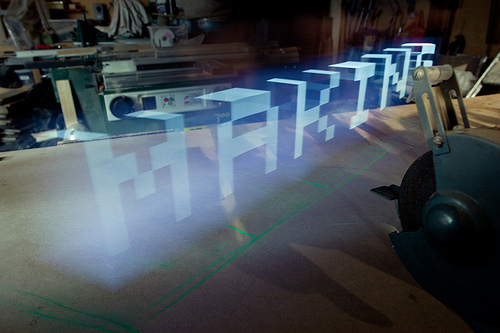
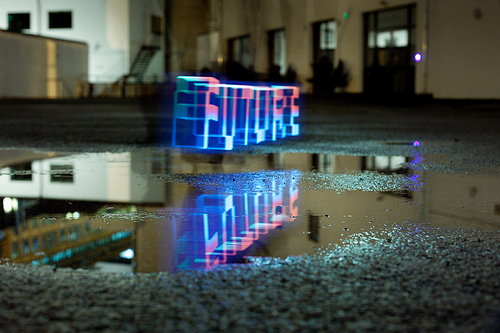
 [Images: From Making Future Magic by BERG/Dentsu London, courtesy of BERG Studio].
[Images: From Making Future Magic by BERG/Dentsu London, courtesy of BERG Studio]. As City of Sound writes, the film suggests that the "grain" of experimental future media—or, rather, the experimental reuse of existing media—will always start off "slightly awkward, incomplete, jittery, fizzing in and out of focus. And yet magical. Coverage is patchy, positioning vague, interaction is compromised yet the capabilities of people, buildings and cities are extended nonetheless."
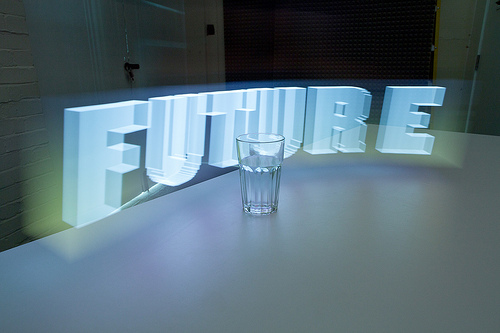 [Image: From Making Future Magic by BERG/Dentsu London, courtesy of BERG Studio].
[Image: From Making Future Magic by BERG/Dentsu London, courtesy of BERG Studio].This particular effect—caused by images that have been animated on the screen of a moving iPad that is then photographed in timelapse—could easily be scaled up. Everything from LEDs on the bottoms of glass-walled elevators to special lights in passing cars and buses could be given three-dimensional content: unexpected forms of content projected into the urban air and only detectable, or legible, on a different temporal register.
The optical future of architectural ornament: light with content.
That is, you get home with your digital camera and you click back through to see what you've photographed—and there are words, shapes, and objects hovering there in the street, or inside the buildings you once stood within, visual data only revealed through long-exposures.
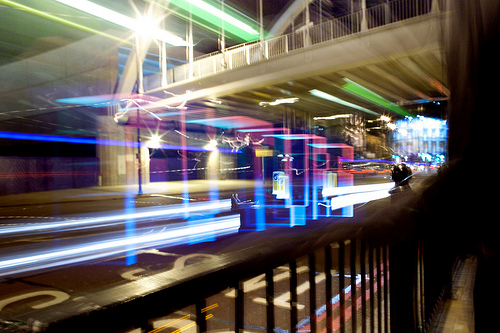 [Image: From Making Future Magic by BERG/Dentsu London, courtesy of BERG Studio].
[Image: From Making Future Magic by BERG/Dentsu London, courtesy of BERG Studio].The possibilities for creating 3D information displays hidden in a kind of acute angle to the present moment—literally on display right in front of you but only visible later, when filtered through a timestretched medium—are mindboggling. It's like the present moment is coinciding with a much larger holograph—the present moment as an airplane flying through a cloud.
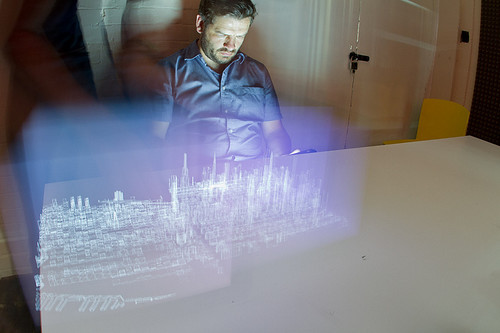 [Image: From Making Future Magic by BERG/Dentsu London, courtesy of BERG Studio].
[Image: From Making Future Magic by BERG/Dentsu London, courtesy of BERG Studio].To say that this exact technique will soon be popping up as a special effect in feature films is, I think, an understatement. It's the new bullet time, perhaps: little screens attached to automated tracks, whirling around a film set, spinning words, ghosts, and images through space.





Comments are moderated.
If it's not spam, it will appear here shortly!
interesting...
sounds a bit like the 'airtagging' feature in The Curfew:
http://www.thecurfewgame.com/
(disclosure - i work for C4, who commissioned this game)
It is "ghostly"...like capturing an orb in a photograph. I wonder if the practical application of this will become like a static form for advertising.
"To say that this exact technique will soon be popping up as a special effect in feature films is, I think, an understatement. It's the new bullet time, perhaps: little screens attached to automated tracks, whirling around a film set, spinning words, ghosts, and images through space."
Wow, hyperbolae!! All respect to the Berg crew it's a very nice effect, but do you seriously think that this is the new bullet time? It's a lo-fi version of the kind of SFX we have already seen in films, from Minority report to, oh, Star Wars, and creeping further back.
Bullet time was good because it merged real action with SFX, what is going on here is real action trying to hide itself within photography. Totally different.
But very pretty.
Very nice, although I find the stills much more evocative than the stop-frame animation.
Thanks for the link mate, and I like your take on it, the idea of the "acute angle to the present moment". It reminds me of Pallasmaa's thoughts on the importance - and general undervaluing in architectural discourse and imagery - of peripheral vision.
Post a Comment